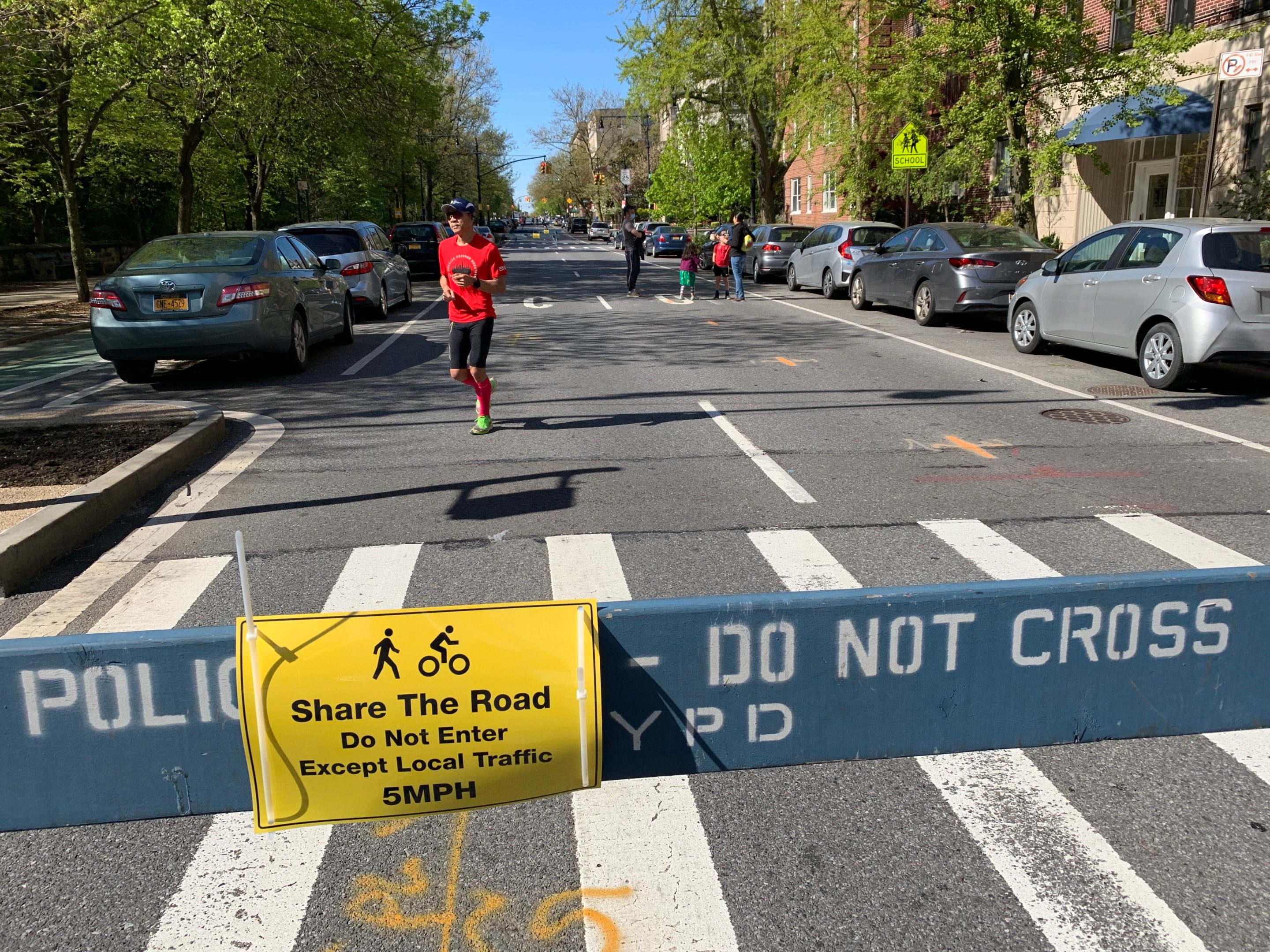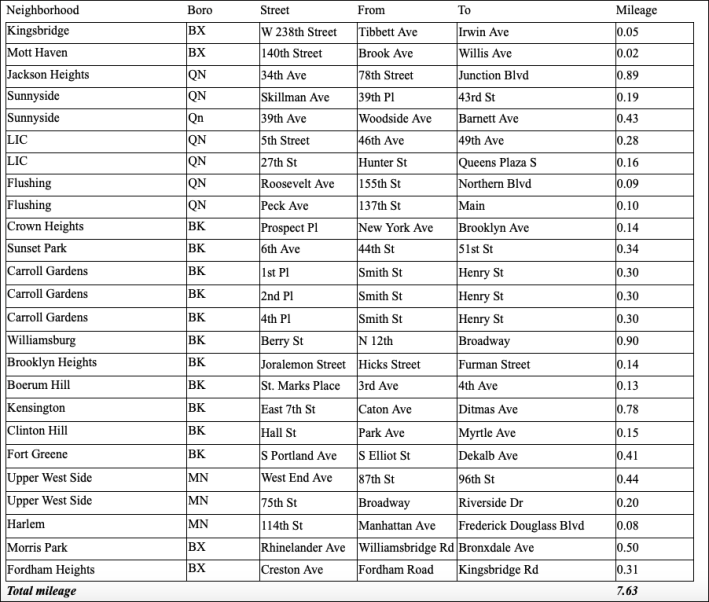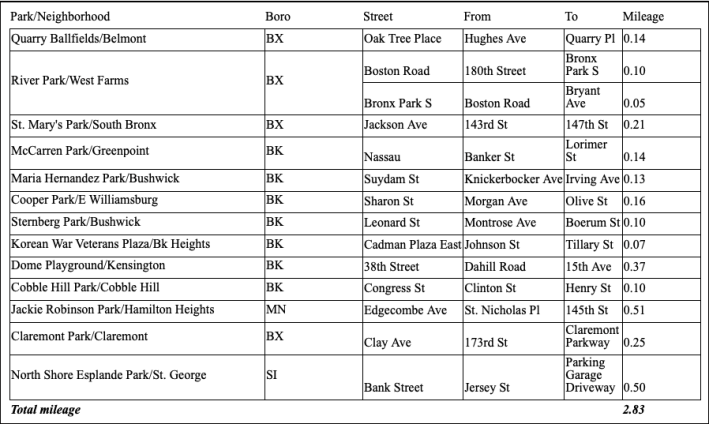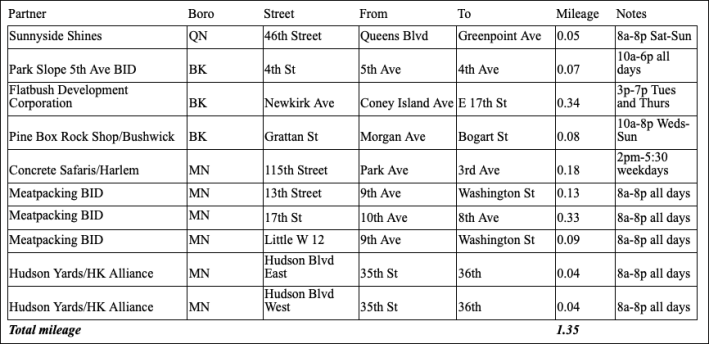Twelve more miles of open streets will join the growing network on Thursday, bringing the mayor halfway to his goal of opening up 40 miles of roadways this month for socially responsible recreation — though critics complained of the piecemeal process for creating open streets and others groused that the mayor was announcing new bike lanes that are not new at all.
First, the latest list of 12 miles. The majority — 7.6 miles — will involve the local precinct, though City Hall did not immediately explain the role of the police:
More than 2.8 miles will be in or adjacent to parks:
A small portion — 1.3 miles — will be overseen by local business improvement districts:
"We want to make it easier for people to socially distance and this open streets initiative is helping to do that," the mayor said.
Not everyone was impressed, given that New York has more than 6,000 miles of roadways that are almost entirely used for the movement and storage of cars and trucks:
The mayor also announced 9.2 miles of new protected bike lanes, though most were already in the works before the crisis (see links), reminding again that the city could just do these street safety improvements whenever it wishes:
- Broadway from Barclay Street to Morris Street in the Financial District (this half-mile stretch starts on Thursday)
- 38th and 39th streets from First Avenue to 11th Avenue (3.9 miles).
- Crescent Street from Queens Plaza to Hoyt Avenue in Astoria (1 mile).
- Fourth Avenue from First Street to Flatbush Avenue in Brooklyn (an unfinished 1.4-mile segment of a stalled project).
- Ashland Place and Navy Street from Hanson Place to Sands Street in Fort Greene and Vinegar Hill (1.1 miles).
- Flatbush Avenue from Grand Army Plaza to Ocean Avenue in Brooklyn (1.3 miles).
Oddly, The Bronx was left entirely out of the announcement. The borough is the only area of the city experiencing an increase in cyclist injuries this year, as Streetsblog reported last month.
It is unclear if these 9.2 miles of PBLs represent all that the city believes it will be capable of building this year. The city had originally promised to build 30 miles of protected bike lanes in 2020, but that promise came before the coronavirus pandemic shuffled the deck chairs. The mayor has already cut millions in funding from key Vision Zero programs.
On Tuesday, Department of Transportation Commissioner Polly Trottenberg said that the department would be unable to even finish the final portion of its Queens Boulevard safety redesign as expected this year.
On Wednesday, Trottenberg said that it's unclear if the city will be able to do much more than the lanes above.
"We would like to do more lane miles this year, but we will have to see," said Trottenberg, who had earlier in the year promised major expansions of the bike network to cover known danger zones in Manhattan and Brooklyn.
She also said that the 9.2 miles of lanes announced on Wednesday are technically "temporary" because the city is required to give the City Council 90 days of warning whenever it installs a bike lane — a weird answer, given that most, if not all, of the lanes have been discussed for far longer.
Queens Council Member Costa Constantinides pointed out that "Crescent Street deserved this protected bike lane long before this pandemic shut down New York City" and, indeed, had already been presented to the local community board.
Nonetheless, he pronounced himself "thrilled to see its construction finally begin."
"Going to work shouldn't be a daily life-or-death scenario, but sadly it too often is," he said. "Those who can cycle deserve a safe north-to-south route, from the Triboro Bridge to the Queensboro Bridge. I hope this is just the first step in creating a holistic transit network for western Queens."
Former DOT official Jon Orcutt has long sought a smoother process for building bike lanes, but he was pleased with Wednesday's update.
"Generally I would like a more straightforward process where the city moves ahead to connect up our protected bike network without granting vetos or infinite delays to community boards or local officials, but taking advantage of this situation with much less traffic is unique and good to see the city acting upon," he said.
But all of Wednesday's announcements, taken together, show that the city is speeding up its promise to deliver open space more broadly. The first seven miles of open streets, announced two weeks ago, were mostly on roadways inside, and adjacent to, parks. A week later, the mayor added two more miles of roadways overseen by business groups.
The mayor's announcement comes one day after restaurant owners went public with their request to take over miles of streets for al-fresco dining. Industry leaders argue that they need extensive open space — in the roadbeds of many residential and commercial zones — to jumpstart the economy and serve the public, but do so in a responsible, safely distanced manner.
Hizzoner said he was "intrigued" by the idea, but is still looking into it. The comment is an echo of the process by which he slowly came to accept the model of many other cities, namely that open streets could be done without substantial police enforcement.
The same process may be playing out. Cities such as Tampa, Cincinnati and Vilnius in Lithuania are already barring cars on many streets to help the struggling restaurant industry.








